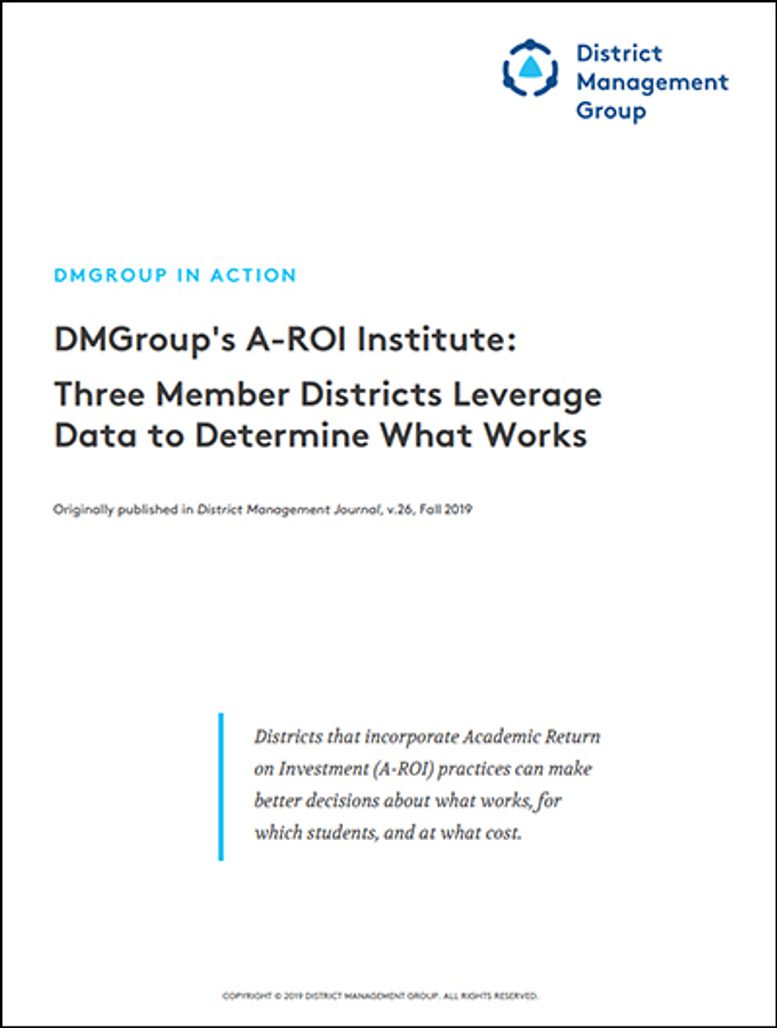In June 2017, three innovative districts selected their top leaders to participate in a year-long training course on Academic Return on Investment (A-ROI). The objective was to learn specific approaches and tools for integrating data into resource allocation decisions to ensure the greatest possible impact from district budgets.
Each of these districts was facing different challenges:
- Boulder Valley School District (CO) was expecting a new superintendent and a new strategic plan — the district needed a framework to determine what was working best;
- Beaverton School District (OR) was facing steep cuts in state budgets and wanted to use A-ROI to make thoughtful budget decisions;
- Tigard-Tualatin School District (OR) was making a big investment in technology to transform instruction — the district sought to develop the tools needed to measure impact.
DMGroup’s A-ROI Institute provided the participants with the tools and training needed to address these challenges by using data so that resources could be allocated to maximize impact on student outcomes.
DMGroup’s A-ROI Institute: How It Works
Since 2013, DMGroup has worked with dozens of districts to help conduct in-depth A-ROI evaluations of key district programs. From this experience, DMGroup developed training materials to support districts in building in-house capacity for A-ROI work. In 2017, DMGroup launched the first year-long A-ROI Institute in partnership with the Government Finance Officers’ Association (GFOA), a nonprofit professional association for business officers based in Chicago.
The three districts participating in the 2017–2018 A-ROI Institute learned to conduct a rigorous A-ROI analysis using DMGroup’s 10-step process to assess both outcomes and cost. The Institute provided a hands-on learning experience for district leaders through a combination of in-person workshops and personalized coaching for district teams.
Phase 1 — Kick-Off
The Institute kicked off with a web-meeting workshop to bring the districts together and provide an initial overview of the A-ROI approach. Districts also received their first two assignments: using a DMGroup tool to determine which program they wanted to analyze and completing a self-assessment exercise to determine their organization’s readiness to implement A-ROI.
Each district had a follow-up coaching call with a DMGroup expert to talk through the results of the self-assessment and develop a plan to address areas in which they needed to build capacity.
Phase 2 — Training and Workshops
The districts gathered together at GFOA’s Chicago office for a full day of training and workshops to design their approach to analysis and thoughtfully set targets for the programs they were evaluating.
Over the months that followed, DMGroup helped the districts with data collection and analysis of program costs. Mid-year, a second training workshop was held to explore the nuances of interpreting statistical results. Together, districts reviewed a case study of a real district that had used A-ROI to evaluate and make changes to its gifted/talented program. Following the training, each district continued work on their respective analyses.
Phase 3 — Presenting Results
The three districts gathered together for a workshop in the spring, and each district presented the results of their analyses and their plans to further integrate A-ROI into district practices.
- Boulder Valley had built a common language among leadership to discuss the efficacy of programs and, in advance of an upcoming strategic planning process, decided to embark on an effort to use A-ROI to assess every program and initiative in the district.
- Beaverton found positive gains for students on end-of-year assessments, and also used the process to thoughtfully adjust their implementation as they rolled out the initiative districtwide.
- Tigard-Tualatin had used the A-ROI approach to examine whether the investment in 1:1 technology had made a meaningful impact on instructional practices. The district identified steps to address certain schools and student groups that had not seen as much impact as others.
A-ROI Institute Instructor,Districts that incorporate A-ROI practices can make better decisions about what works, for which students, and at what cost.
DMGroup
Ongoing Impact
After completing the year-long A-ROI Institute training, these districts continued to work with DMGroup for a second year of training. All three districts have deeply integrated A-ROI into their work, conducting data-driven evaluations of key programs and developing new approaches to link budgets to district strategy. Beaverton created a Program A-ROI template, asking leaders of all key programs to propose metrics and targets and conduct cost analyses. Boulder Valley is continuing to examine their budget and resource allocation processes.
Perhaps the biggest impact came in the smallest district, Tigard-Tualatin School District. The superintendent, CFO, and budget director testified to the Oregon state legislature about their use of A-ROI ahead of a key vote to add $2 billion in education funding for the state. Their experience may help persuade legislators that Oregon districts can develop systems and skills to manage resources more effectively if they are given this boost in funding.
While it is not easy work and takes significant commitment from leadership, districts that incorporate A-ROI practices can make better decisions about what works, for which students, and at what cost. A-ROI helps districts make every dollar count and go toward what helps students most.

DMGroup's A-ROI Institute: Three Districts Leverage Data to Determine What Works
By participating in DMGroup's year-long Academic Return on Investment (A-ROI) Institute training program, leaders from three innovative districts learned specific approaches and tools for integrating data into resource allocation decisions to address their unique challenges and ensure the greatest possible impact from their district budgets.
Download
